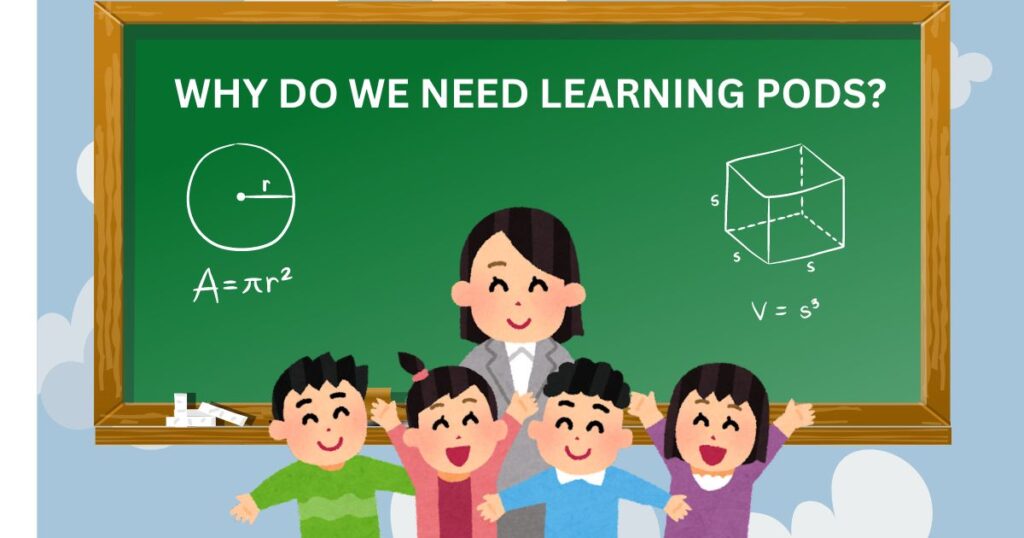Why do we need learning pods?

Imagine a world where children are more than excited to study. A world where they don’t get burned out due to academic stress. A world where they wait for mondays more than the usual sundays. Well, with the arrival of learning pods, this may now be a reality. This is the magic of learning pods- a system that breaks the shackles of traditional classrooms and invites students into a nurturing learning environment making study fun and interesting. You must have heard a lot about learning pods, especially after Covid-19, but what are they exactly, how do they work and why do we need them? What is a learning pod? Before we understand “why do we need learning pods?”, it’s essential to clear the basics. So, a learning pod is basically a small group of students (‘micro school’) who study together outside of a regular school, often in someone’s home or a local community space. These groups are alternative education methods, usually led by a tutor, teacher, or even a parent, offering a more personalised learning experience. Learning pods are smaller than traditional classrooms. There are n number of benefits of small group learning. Children who might feel ignored or lost in the traditional classrooms of 50-60 students, get proper guidance and attention here. Also, this allows the lessons to be more specific to their individual learning styles. And these pods are just not limited to bookish knowledge and academics, they go beyond it by focusing on students’ emotional and social growth. Why do we need learning pods? Now that you have a clear idea of what are learning pods, it’s time to understand the “why” behind the idea. 1. Personalised Learning Experience In a traditional classroom with 30-40 students, it’s tough for teachers to give everyone the attention they need. Let’s be honest, it’s not even possible. Some students excel, while others may feel left out. This is where learning pods stand out. With only 5 to 10 students in a group, learning pods offer a much more personalised and focused environment- providing them the benefits of small group learning. In these smaller settings, teachers can give lessons as per child’s learning pace, strengths, weakness etc. If one student is great at maths but struggles with reading, the teacher can adjust the course and content to help them grow in both areas. Similarly, if a child loves arts more than science, they can explore their interests more freely. Learning pods make sure that every student can learn in their own way, without the pressure of keeping up with an entire class. I bet this is what we all desperately wanted when we were kids. But, nonetheless- better late than never! 2. Bridging the Gaps in Traditional Education Secondly, learning pods help in closing those gaps that are left in traditional schooling. How? Let’s see. Being completely honest, traditional schools, with their strict schedules and rigid course structure, don’t always work for every child. And, that is the reason why this notion of schools being the villain was born. Because, it’s very obvious that some kids learn best by doing practical activities like games, while others prefer in smaller and quieter settings. And a normal traditional school cannot do that. But, learning pods? They are way ahead in this game. Here, learning isn’t rushed or limited to a rigid schedule. It’s flexible, engaging, and moves at the pace of each child. Instead of just quickly going through the course material to prepare for the test, kids get to explore subjects that genuinely interest them. Most importantly, they have the freedom to study more about the topics they like. In an interview with people managing learning pods at different locations, one thing that was almost the same every time- kids staying longer than usual hours to study because of their passion and love for that subject/ topic. You wouldn’t see things like this happening in a traditional school setup. 3. Emotional Well-being and Social Connections As per a report, about one-thirds (32.6%) of the students were symptomatic of psychiatric caseness and 81.6% reported examination-related anxiety. Your child could be one of these. Is it now scary enough to grab your attention? We have to understand that mental health is real. And children too get exhausted and tired. We just cannot talk about education without addressing the emotional well-being of our children.The feeling of studying with a large group (like the crowd at Kota and famous coaching centres) makes a child overwhelmed and an environment like that can lead to children feeling disconnected or even anxious. Learning pods, however, offer a close community, where children can bond on a deeper level with both fellow students and teachers. It is no lie that the emotional support that comes from a small group setting is invaluable. Emotional backing is one of those many benefits of small group learning. When children feel seen and heard, they grow in confidence. They learn to express themselves, ask questions without fear, and build lasting friendships. It’s not just their academic skills that develop; their emotional intelligence and social skills grow beautifully as well- which gives them an all round personality development. 4. A Safe Learning Environment We all know what happened in 2020. Lives were changed! The COVID-19 pandemic shook the foundations of traditional education. Schools closed their doors, and millions of students had to shift to online learning. During this time, many parents realised that virtual classes just weren’t enough. They lacked the personal connection and real life engagement that kids truly require. That’s when organisations like ApniPathshala came forward with learning pods. That’s when learning pods became a lifeline for many families! With learning pods, parents and teachers could create a safe, small group setting where children continued to learn without the risks of larger classrooms. With lesser students, proper distance and hygiene- learning pods leveraged the benefits of small group learning in a great way. These pods gave parents more involvement in their child’s education,
